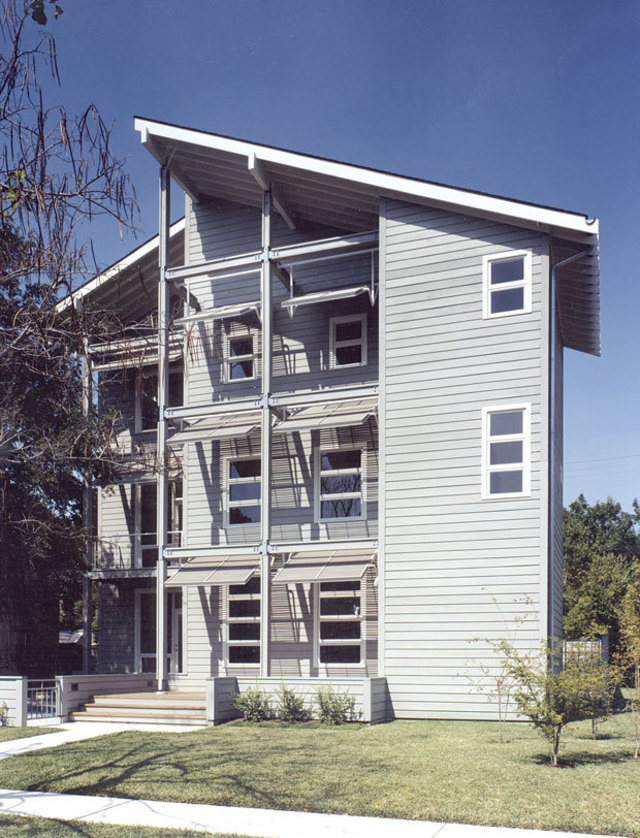The Loyal Opposition

William Frederick Stern, one of Houston’s most influential architects, passed away this year.
Image: Eric Hester
In the early 1990s, McDonald’s opened a new drive-through restaurant on Main Street in downtown Houston. Most people probably didn’t even notice the arrival of yet another fast-food franchise, but to architect William Frederick Stern the McDonald’s represented the latest in a series of outrages perpetrated by corporations against Houston’s historic downtown. “[The] domain of the street is perpetually under siege,” Stern railed in the Fall 1991 issue of Cite, the magazine he co-founded and helped edit. “While a McDonald’s per se could be a reasonable part of downtown, particularly if it were designed as part of the continuous storefront edge of Main Street, in this case the street edge has been violated.”
Stern, who died in March of pancreatic cancer at the age of 66, was as rigorous and uncompromising as the buildings he designed. For almost 40 years, he dominated and shaped the city’s architectural scene much as Dominique de Menil dominated the arts scene; it’s no surprise that the two were mutual admirers, or that in the late-1990s Stern received the commission to restore the de Menils’ Philip Johnson–designed home in River Oaks. Like Dominique, Stern wore many hats. He ran his own architectural practice; taught at the University of Houston; helped edit Cite; campaigned to preserve historic Houston buildings; and amassed a distinguished art collection, which he bequeathed to—where else?—the Menil Collection. “His contribution to the architectural culture of Houston was really immense,” says architectural historian Stephen Fox.
Stern also had an immensely difficult personality. Fox, who worked with Stern at the Rice Design Alliance and on the editorial board of Cite, says that people quickly learned to fear the architect’s cutting intellect. “Even with his sudden death, a lot of friends still talk about their ambivalent reactions to him,” says Fox. “Although Bill could be very warm and generous, he could also be acerbic, condescending, dismissive, mean, and arrogant. If you stayed friends with Bill, you learned to take those characteristics together—you didn’t get one without the others.” When it came to architecture, Stern demanded the best, from himself and from others, and had no compunction about calling out sloppy work. “Bill had these incredibly high standards,” says Lisa Gray, the editor of Cite from 2001 to 2003. “He wanted things to be rigorous. And being rigorous in a blobby city like Houston is a hard role to play.”
Stern embraced his self-appointed role as Houston’s fiercest architectural critic with gusto, publishing editorials in Cite lamenting the city’s incoherent planning, disregard for its past, and general lack of good taste. Over time, many of Stern’s friends came to suspect that beneath Stern’s fiery jeremiads lay a deep, well-concealed love for the city’s eccentricity. “He would always be campaigning for the preservation of some building, and every time they got torn down he would be devastated,” Gray says. “And then he would be furious about something else a couple of weeks later—there would be some outrage, some incredibly stupid remodeling going on, some lack of taste that would infuriate and energize him again. He definitely enjoyed that kind of argumentative engagement.”
Perhaps because of his notorious temper, Stern remained the only principal at his architectural firm, William F. Stern & Associates, for its first two decades. The first architect whose name he deemed worthy to join his on the firm’s shingle was David Bucek, whom Stern hired straight out of graduate school in 1992 and made a principal in 1999, changing the name of the firm to Stern and Bucek. (Daniel Hall later became the third principal). Bucek says that Stern’s perfectionism pervaded the entire office. “One of the things Bill instilled in us is that if you’re going to do something, make it good,” Bucek says. “Make sure there’s beauty in it. As an architect, you have to deal with a budget, and the building has to function, but if it doesn’t look good, why bother?”

Stern’s Museum District home, Courtesy Stern and Bucek Architects.
Bill Stern was born in Cincinnati in 1947, the scion of an Ohio family that had made a fortune in shoe manufacturing. Like his father, he went to Harvard College, then stayed to earn a Master of Architecture degree from the university’s Graduate School of Design. Upon graduation, Stern followed the path of countless young architects before him to New York City, where he joined the office of Edward L. Barnes. Unfortunately, Stern arrived in New York during one of the worst economic slumps in the city’s history—in 1975, the city was nearly forced to declare bankruptcy. The entire US economy was reeling from the effects of the ongoing Arab oil embargo. Well, perhaps not the entire US economy. One American city was not only surviving the embargo but profiting from it.
“At that time, because of the oil embargo, Houston was like Dubai, basically,” Bucek says. “This is where they were building skyscrapers—there was the promise of work, and architects are always looking for work.” After reading a story about Houston in the New York Times, Stern moved here in 1976 and quickly found a position at architecture firm Morris Aubrey; three years later, he left to open his own office. “It’s the kind of thing that happens to a lot of people,” says Stephen Fox. “They come to Houston thinking that they’ll stay a few years and then move on. And instead, without quite intending to, Houston becomes their home.”
As is the case with most fledgling architects, Stern’s first commissions consisted largely of renovations and small additions to existing buildings. But in oil-rich Houston it wasn’t long before Stern began to design larger buildings. Townhouses were in vogue at the time, and in the early 1980s Stern received his largest commission to date, a large complex of 18 condominiums in the Heights that became known as Arlington Court. With its charming gatehouse, a central greensward, and townhouses featuring prominent chimneys and high-pitched roofs, the development is still considered one of the city’s finest examples of postmodern design and established Stern as a major Houston architect. For his part, Stern hated being called a “postmodernist.” He worked in so many different styles over the course of his career that it’s almost impossible to identify a Stern building at first glance, the way it’s possible to spot a Frank Gehry or Michael Graves design. According to Fox, Stern was more interested in architectural integrity than in establishing a personal brand. “Architecture for him was more about quality, or what he regarded as good and conscientious design.”
During the oil bust of the late-1980s, architectural commissions dried up across the city and Stern turned his attention to designing a house for himself in the Museum District. With its louvered sunscreens and gray paint, the three-story house evokes Renzo Piano’s Menil Collection building and was designed to house Stern’s growing art collection, including a Sol LeWitt design painted directly onto the living room wall. But even in his own home, Stern couldn’t escape the city he both loved and hated. “Bill built his own house in a neighborhood without any deed restrictions, and in fact he ended up getting a townhouse development in his backyard,” says Fox. “On the other hand, he loved living in that neighborhood because of its mixed uses. So, in a way, the things that frustrated him the most about Houston were also the things that most excited him.”




